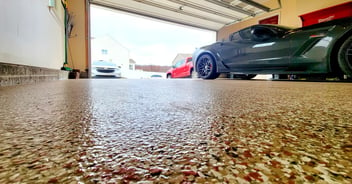As a homeowner, you're always looking for ways to improve and protect your property. When it comes to flooring solutions, polyaspartic polyurea floor coating is a game-changer that you should know about.
What Is Polyaspartic Polyurea?
Polyaspartic polyurea floor coating is an advanced, two-component polymer-based systems that offers superior durability, UV stability, chemical resistance and strength compared to traditional flooring options, such as epoxy and polyurethane.
These high-performance coatings are designed to provide a tough, long-lasting wear surface that can withstand the rigors of daily life in your garage. Polyaspartic Polyurea makes the perfect clear, top coat over a decorative chip coating system (the most popular coating systems used in garage floors).
NOTE: All of this is why Stronghold Floors uses Polyaspartic Polyurea coatings for the top, clear coat on all garage floor coatings.
Key Benefits for Homeowners

Exceptional Durability: Polyaspartic polyurea coatings create a surface that's resistant to impact, abrasion, heat, and chemicals. This means your floors will look great and perform well for years to come, even in high-traffic areas.
Quick Installation: One of the most appealing aspects of polyaspartic coatings is their fast cure time. This allows the chemical system to return to service (i.e. use your garage) days sooner than if traditional epoxies and polyurethanes are used for the clear coat on a decorative chip floor.
Low Maintenance: These coatings are incredibly easy to clean and maintain. A simple damp mop is usually all you need to keep your floors looking pristine (more about cleaning the coatings can be found at 12 Tips for Use & Care of Your Coatings.
Aesthetic Appeal: Polyaspartic Polyurea coatings offer a smooth, glossy finish that enhances the appearance of your space.
Why Choose Polyaspartic Polyurea Over Other Options for Clear Coats?

Compared to traditional epoxy coatings for the top clear coat, polyaspartic polyurea offers several advantages:
- UV Resistance: Unlike epoxy and polyurethane, polyaspartic polyurea coatings won't yellow or degrade when exposed to sunlight, making them ideal for garages that have greater sunlight exposure (such as south facing garages).
- Chemical Resistance: These coatings stand up better to oils, grease, and other chemicals, which is particularly beneficial for garage floors.
- Temperature Tolerance: Polyaspartic coatings can withstand extreme temperatures, making them suitable for both indoor and outdoor use in various climates.
- Long-Term Value: While the initial cost may be higher than some alternatives, the durability and low maintenance requirements of polyaspartic coatings make them a cost-effective choice in the long run.
Polyaspartic Polyurea vs Polyaspartic Polyurethane
Polyaspartic polyurea and polyaspartic polyurethane are both high-performance coating materials, but they have some key differences:
- Chemical composition (let's get technical for a minute)
- Polyaspartic polyurea is formed by reacting an aliphatic polyisocyanate with a polyaspartic ester (an aliphatic diamine).
- Polyaspartic polyurethane combines polyaspartic technology with traditional polyurethane chemistry.
- UV stability (very important for the long haul)
- Polyaspartic polyurea is inherently UV stable due to its aliphatic structure, which prevents yellowing and degradation when exposed to sunlight.
- Polyaspartic polyurethane also offers UV resistance, but it may vary depending on the specific formulation.
- Curing time (important only for return to service time)
- Polyaspartic polyurea generally has a faster curing time, with some formulations ready for foot traffic in as little as 1-4 hours.
- Polyaspartic polyurethane typically has a slightly longer curing time compared to polyaspartic polyurea, but still faster than traditional polyurethanes.
- Application (really important for proper system design and installation)
- Polyaspartic polyurea can often be applied in a single coat at higher thicknesses (up to 16-18 mils or more).
- Polyaspartic polyurethane may require multiple coats for optimal performance, depending on the specific formulation.
- Moisture sensitivity
- Polyaspartic polyurea is less sensitive to moisture during application compared to traditional polyurethanes.
- Polyaspartic polyurethane generally has improved moisture tolerance compared to conventional polyurethanes, but may still be more sensitive than polyaspartic polyurea.
- Chemical resistance
- Both polyaspartic polyurea and polyaspartic polyurethane offer good chemical resistance, but polyaspartic polyurea may have a slight edge in this aspect, depending upon the types of chemical exposure.
While both coatings offer high performance, polyaspartic polyurea generally provides faster curing times, better UV stability, and higher moisture tolerance, making it suitable for a wider range of applications.
Polyaspartic polyurethane is a type of coating material that combines the properties of polyaspartic and polyurethane technologies.
Want to know more?
Hope this helps everyone to understand why polyaspartic polyurea offers a combination of durability, aesthetics, and convenience that make them an excellent choice for homeowners looking to upgrade the top coating of their garage flooring solution.
What about the bottom coating layer? Check out Polyaspartic vs Epoxy: Which is better and why? as we discuss why epoxy offers the best qualities for a base (bottom) coating layer in a decorative chip system.




%20(1).jpg?width=352&name=20220306_142919%20(2)%20(1).jpg)

